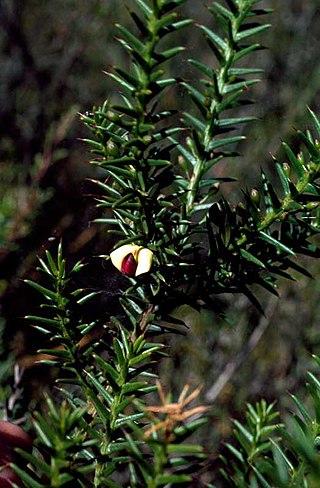
Bossiaea buxifolia, commonly known as matted bossiaea, is a species of flowering plant in the family Fabaceae and is endemic to south-eastern Australia. It is a prostrate to weakly erect shrub with elliptic to egg-shaped or almost round leaves and yellow, red and purplish flowers.

Bossiaea spinosa is a species of flowering plant in the family Fabaceae and is endemic to the south-west of Western Australia. It is a low, dense prostrate or rounded, twiggy shrub with egg-shaped to elliptic leaves and deep yellow to orange and pinkish-red, pea-like flowers.

Grevillea pulchella, commonly known as beautiful grevillea, is a species of flowering plant in the family Proteaceae and is endemic to the southwest of Western Australia. It is a spreading shrub usually with pinnatisect leaves, and cylindrical clusters of white to cream-coloured flowers.

Bossiaea tasmanica is a species of flowering plant in the family Fabaceae and is endemic to Tasmania. It is a prostrate or low-lying shrub with spiny branches, elliptic to egg-shaped with the narrower end towards the base, and yellow and red to pink flowers.

Daviesia hakeoides is a species of flowering plant in the family Fabaceae and is endemic to the south-west of Western Australia. It is a shrub with many tangled stems, scattered sharply-pointed phyllodes and yellow or orange and dark red flowers.
Bossiaea barbarae is a species of flowering plant in the family Fabaceae and is endemic to Western Australia. It is an erect, compact, spiny shrub with egg-shaped to elliptic or oblong leaves, and deep yellow and bright red flowers.
Bossiaea cucullata is a species of flowering plant in the family Fabaceae and is endemic to Western Australia. It is a dense, many-branched shrub with narrow-winged cladodes, leaves reduced to dark brown scales, and yellow and deep red or pale greenish-yellow flowers.
Bossiaea eremaea is a species of flowering plant in the family Fabaceae and is endemic to Western Australia. It is an openly-branched, spreading, more or less leafless shrub with deep yellow and purplish flowers.
Pultenaea pinifolia is a species of flowering plant in the family Fabaceae and is endemic to the south-west of Western Australia. It is an erect, slender shrub with pine-like leaves and yellow-orange flowers with orange marks.
Bossiaea obovata is a species of flowering plant in the family Fabaceae and is endemic to eastern Australia. It is a small, low-lying or prostrate shrub with egg-shaped leaves with the narrower end towards the base, and pea-shaped, yellow and red flowers.
Bossiaea peninsularis is a species of flowering plant in the family Fabaceae and is endemic to the Eyre Peninsula in South Australia. It is an erect rhizome-forming, more or less leafless shrub with leaves reduced to small scales, and yellow, red and purplish flowers.
Bossiaea praetermissa is a species of flowering plant in the family Fabaceae and is endemic to near-coastal areas in the far south-west of Western Australia. It is a shrub with many flattened, winged cladodes and deep yellow and reddish or maroon flowers.
Bossiaea preissii is a species of flowering plant in the family Fabaceae and is endemic to the south of Western Australia. It is a compact, glabrous shrub with egg-shaped leaves with the narrower end towards the base, and yellow, red, orange or apricot-coloured flowers.

Bossiaea rufa is a species of flowering plant in the family Fabaceae and is endemic to the south-west of Western Australia. It is a loose, many-branched shrub with elliptic to egg-shaped leaves with the narrower end towards the base, and deep yellow and red flowers.

Bossiaea scortechinii is a species of flowering plant in the family Fabaceae and is endemic to eastern Australia. It is a prostrate to low-lying shrub with simple, elliptic to egg-shaped leaves with the narrower end towards the base, and orange-yellow flowers with red to pinkish markings.
Bossiaea smithiorum is a species of flowering plant in the family Fabaceae and is endemic to the south-west of Western Australia. It is a slender shrub with oblong to cylindrical leaves and orange-yellow and red or purple, pea-like flowers.
Bossiaea spinescens is a species of flowering plant in the family Fabaceae and is endemic to the south-west of Western Australia. It is a slender, spreading or compact, spiny shrub with oblong to oval leaves and yellow and reddish-brown, pea-like flowers.

Daviesia preissii is a species of flowering plant in the family Fabaceae and is endemic to the south-west of Western Australia. It is a glabrous shrub with scattered, vertically flattened, tapering, narrowly egg-shaped to elliptic, sharply-pointed phyllodes and yellow and red flowers.

Daviesia spinosissima is a species of flowering plant in the family Fabaceae and is endemic to the south of Western Australia. It is a shrub with crowded, rigid, sharply-pointed, narrowly triangular phyllodes, and yellow and red flowers.

Daviesia trigonophylla is a species of flowering plant in the family Fabaceae and is endemic to the south of Western Australia. It is an erect, bushy shrub with elliptic or egg-shaped phyllodes that are triangular in cross-section, and orange, dark red and maroon flowers.










